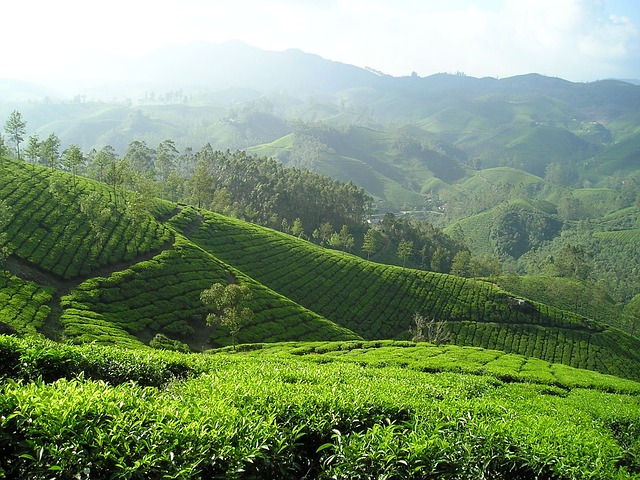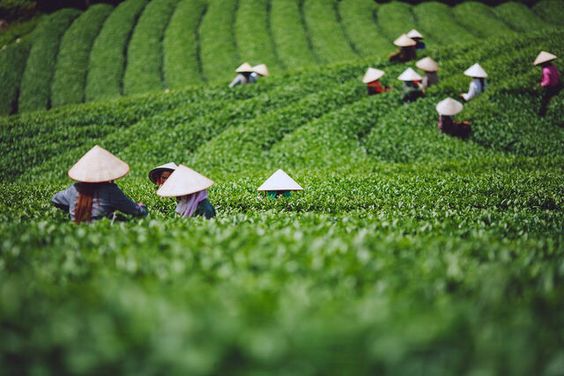Today, we’re going to talk about matcha tea, that popular infusion from Japan that has been gaining more ground thanks to its various benefits, exquisite flavor, and ease of preparation. In this article, we’ll focus on telling you a bit about the history of this beverage, its origin, and what its name means, as well as its preparation process and other interesting facts. Keep reading to learn more.
What is matcha tea?
To begin, matcha tea is a type of powdered tea that comes from China, but its great popularity is due to the Zen monks of Japan. Therefore, the most widely circulated, although incorrect, story is that it originates from the land of the rising sun. However, the earliest traces of this herb are Chinese.
Strictly speaking, matcha tea comes from the blend of the ingredient called tencha, which is a type of tea leaf that has undergone a drying process. However, the essential element that distinguishes matcha tea is that its base ingredient is tencha. When ground, it becomes a fine powder with a bright green color. Its unique flavor and various benefits only help it gain more ground in the Western market.

Discover the history of matcha tea
The history of the first matcha tea dates back to the tea ceremony, which can be traced back to the early 9th century AD in China. Indeed, it is an ancient consumption, considering that the first of these leaves in its most popular variant, namely classic tea, dates back over 4,500 years.
However, the current consumption of matcha tea and its preparation are a legacy of the Song dynasty.. This dynasty was responsible for perfecting the method of processing and preparation of matcha. Thus, they took care to grind these leaves with the well-known whisk that mixes the powder with hot water.
Another interesting fact is that its preparation and consumption were part of the Buddhist ritual chan. According to tradition, the Buddhist monk Saicho, from the Tendai sect, brought the drink to Japan in the early 10th century AD. Since those years until now, Zen monks have been drinking the delicious tea from a large bowl, which serves as a prelude to their long hours of meditation.
Composition of matcha tea
The chemical composition of matcha tea is responsible for the benefits associated with this infusion. Among them, its xanthine bases and polyphenols, such as flavonoids, catechins, catechin tannins, and phenolic acids.
As a tea, its main composition is caffeine, followed by theophylline, theobromine, adenine, and xanthine. Among the flavonoids are kaempferol, quercetin, and myricetin. Its phenolic acids include chlorogenic, caffeic, and gallic acids. It also contains free amino acids such as 5-N-ethyl-glutamine and theanine. Lastly, it has B vitamins and mineral salts such as fluoride.
Thanks to this composition, matcha tea has, among its various benefits, the ability to stimulate the central nervous system. It reduces migraine levels and is known for its antioxidant properties. However, we have prepared a specific article to talk to you about the benefits of matcha tea.
Traditional preparation
You should know that the preparation of matcha tea is not just a matter of cultivation; it is also associated with very delicate work and a spiritual tradition passed down from generation to generation. If we go to the beginning, the work starts weeks before the harvest, which usually takes place in the Japanese spring. During this time, the tea leaves darken as they do not have direct contact with the sun due to the recent winter. As a result, the levels of chlorophyll and amino acids in them are high.
Once harvested, they are briefly steamed. This is done to inhibit the PPO enzyme, which causes oxidation. Additionally, it helps to maintain the color and nutritional qualities. To prevent moisture, the already steamed leaves are dried very slowly. Once this process is completed, the leaf is no longer called "aracha" and becomes "tencha." The latter is the only one that can be used in the production of this tea and receive the designation of "matcha" after the stems and veins are removed.

The next step is the grinding of these leaves., without being exposed to light or heat. To grind them, granite stones are used, resulting in a fine, bright green powder: this is what is known as matcha tea.
The artisanal process takes time; to be specific, approximately one hour to obtain 40 grams of matcha tea. Yes, as you read, that’s why it is valued both in Japan and outside of it.
Processing of matcha
As we mentioned, it is the tencha leaves that are used to make the powder that serves as the base for matcha tea. These leaves are also the raw material for the preparation of the gyokuro, another Japanese green tea. In the case of matcha, the tencha leaves are ground in granite mills at low speed. This is done to avoid overheating the leaves and to preserve their flavor.
There is a standard for grinding tencha. Currently, this ranges from 5 to 10 microns (one millimeter contains 1,000 microns), which results in the matcha powder. With this, we now have the base to prepare a delicious matcha tea.
The truth is that depending on the time of cultivation, commercial brands, and other variations, this traditional tea can be prepared in many ways. To help you with this, we have related articles that detail both the ways to prepare matcha tea and the flavors it can have depending on the harvest time because, yes, there are qualities based on the month in which the leaves were picked.



